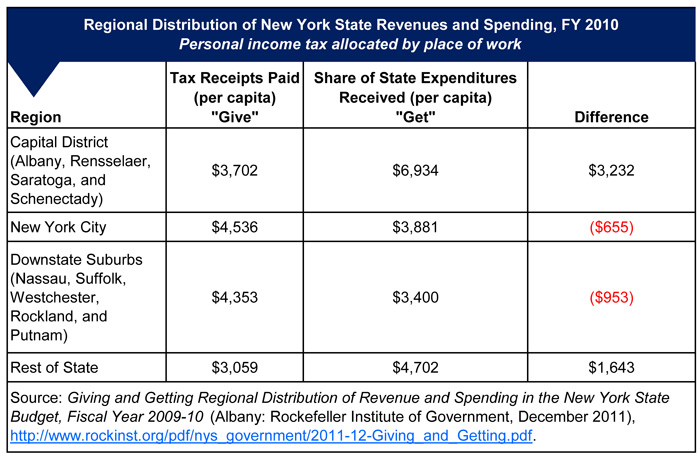Yesterday, the US House of Representatives announced details of their tax reform proposal. While there were many significant changes to the tax code that could affect federal debt, the proposal has a particularly negative effect on New York State. The Empire Center for Public Policy recently found the House Republican proposal would result in “boost[ing] the state’s tax price to as much as 13 percent, by far the highest level ever.”
Originally, the House Republicans sought to eliminate the State and Local Tax (SALT) deduction altogether and, as a recent Rockefeller Institute study found, that would have had a deleterious effect on New York, especially given that New York taxpayers “give” more than $48 billion in taxes than they “get” back in federal spending.
To try and gain more support, House Republicans modified the proposal to eliminate the deduction altogether except for property taxes, which was capped at $10,000. Dramatically capping and eliminating SALT would still negatively impact New York State — but this particular proposal would burden high-income, high property-tax areas downstate. Representative Peter King (R) of Long Island recently said, “It will raise taxes on my constituents who will be subsidizing tax cuts for the rest of the country.”
However, the modified SALT deduction has taken the sting out of the proposal for congressional districts with lower incomes, especially upstate, creating a division among New York House Republicans along upstate/downstate dividing lines. Yesterday, as reported by the State of Politics, Representative Tom Reed of the Southern Tier and Western part of the state came out in favor of the proposal, while others, like Peter King and Long Island Representative Lee Zeldin came out against it. For all Republicans, it shows an emerging regional divide largely based on potential winners and losers in their respective districts. Given that Representative Zeldin has a district consisting of higher incomes and salaries, the capping of SALT will still have a significant negative effect — or a tax increase — for Zeldin’s constituents, but not necessarily Representative Reed’s.
But, in the End Does Every New York Taxpayer Ultimately Lose?
However, upon closer inspection, the House Republican tax plan may result in a negative effect to upstate districts, like Representative Reed’s, because of who “gives” and who “gets” in New York State. Although the report is several years old, the Rockefeller Institute of Government and the Citizens Budget Commission found that New York City and downstate suburbs (Nassau, Suffolk, Westchester, Rockland, and Putnam) “give” more in taxes than they “get” back in spending, while the rest of the state, like upstate, gets more in spending than their residents and business “give” in taxes.
Even if upstate residents receive some tax relief under the House Republican proposal, they still may end up on the losing end because much of their government revenue comes from high income individuals in downstate areas. If higher earners downstate face this unprecedented tax increase, it could very well drive their behavior, like leaving New York. If that is the case, those upstate communities would feel the pain, too, in reduced revenue for schools and other services in their communities — thus, killing the golden goose. Therefore, this proposal needs much more careful analysis on the impact to the state and its residents. Although, the proposal may appear to benefit some in New York, it may be too good to be true.


